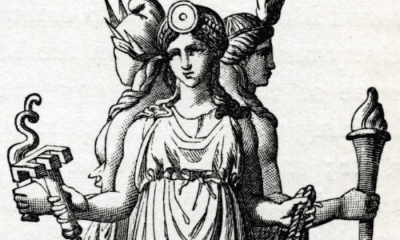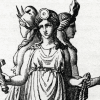Greek
The Golden Ram and Its Fleece
The story of Jason is a famous legend, but how much do you know about the golden ram whose fleece he stole? Read on to learn more about Chrysomallos, the legendary golden ram!
Many people are familiar with the story of Jason, the prince who sailed with the Argonauts on a quest to obtain a legendary golden fleece. He earned his throne, and a curse, with the help of the witch Medea.
The story of how that fleece came to be is nearly as amazing as the epic tale of Jason’s voyage on the Argo. Although less well-known to many people, the golden ram’s rescue of two endangered children was another daring tale.
The golden ram inspired the name of a body of water, an astrological constellation, and an epic quest story that has been popular for nearly three thousand years. Where did the Greeks get the idea for the golden ram and its amazing fleece, though?
The Stories of the Golden Ram
The story of Jason and the golden fleece is famous, but that is not where the golden ram’s tale begins.
The golden ram, Chrysomallos, was an extraordinary creature. The winged ram was a child of Poseidon and one of the daughters of Helios.
Athamas the Minyan, a human king, married the cloud nymph Nephele. They had two children together, a boy named Phryxus and a girl called Helle.
Athamas eventually abandoned Nephele when he fell in love with Ino, the second daughter of Harmonia and Cadmus. When the cloud nymph furiously left her husband’s kingdom, she caused a massive drought to fall over the land.
Ino was jealous of her stepchildren and saw an opportunity to be rid of them. She convinced the king that the only way to lift the drought was to sacrifice his son.
Just as the child was about to be killed, the golden ram swooped down from the sky so he and his sister could ride to safety. Nephele had sent Chrysomallos to rescue her children just in time.
The ram told the children not to look down as they flew toward what is now the country of Georgia. Helle could not resist, however, and fell from the ram’s back when she fainted in fear.
The strait that runs through Turkey was known as the Hellespont, or Sea of Helle, in her honor.
Phryxus was anxious over his sister’s fate, but Chrysomallos calmed him as they flew on. They eventually landed in Colchis at the court of King Aeetes, who welcomed him as a guest in his home.
Phryxus sacrificed the golden ram to Poseidon in thanks, essentially returning it to the god who had created it. Chrysomallus was placed in the stars as the constellation Aries.
King Aeetes hung the ram’s fleece in the sacred grove of Ares in his kingdom where it was guarded by a serpent and fire-breathing bulls. Phryxus married the king’s daughter, Chalciope.
Several years later in the kingdom of Thessaly, the throne had been seized by King Aeson’s half-brother Pelias. The usurper killed all the heirs he could find, but Aeson’s newborn son Jason was spared.
Jason returned to Thessaly when he was an adult and announced that he was the rightful king. Pelias said that Jason could only take the throne if he made the long voyage to Colchis to bring the golden fleece.
A ship was built, the Argo, and a crew of heroes was assembled. It included many notable favorites of the gods including Heracles, Atalanta, the Dioscuri, and Orpheus.
The Argonauts had many adventures on their journey, as detailed in the Argonautica. Finally, they reached Colchis, where Aeetes was still king.
The king granted Jason permission to take the golden fleece if he accomplished a list of seemingly impossible tasks. Jason nearly gave up, but Eros made Aeetes’ daughter Medea fall in love with him and give him her help.
Medea was not only familiar with her father’s tasks, she was also a witch. She made potions and ointments that protected Jason from both the fire-breathing bulls and the serpent.
Jason stole the golden fleece and he sailed away with Medea. Medea distracted her father by killing her own brother so they could escape without being pursued.
By retrieving the fleece of the golden ram, Jason had won the throne of Thessaly. His marriage to Medea would be doomed, however, because of their crime of murder as they fled Colchis.
My Modern Interpretation
The tale of the golden ram and its fleece is not only one of the most famous in Greek mythology, it is also one of the oldest. It was passed down in preliterate times and written about for the first time in the age of Homer.
Because of its age, it’s almost certain that the story changed many times over the centuries. Characters and themes that exist in some retellings were likely added later to reflect the experiences and fashions of the time.
The Argonautica, for example, was not written until the 3rd century BC. It is likely that some features of the story, such as the inclusion of the Harpies and some of the more notable heroes among Jason’s crew, were later additions to tie the story in with other well-known legends, such as Homer’s Odyssey.
To interpret the golden ram, therefore, historians have typically looked past the details that were added later. Instead, they look at the basic actions and characters in the story.
Several theories have likened the golden ram’s fleece to real-world items that would have granted prestige or authority in Bronze Age Greece.
Some have put forth the idea that the ram represents the domestication of sheep and the arrival of that knowledge to Greece. This would have brought prosperity to the region and, likely, have increased the political power of those who owned some of the first imported rams.
Since sheep husbandry developed in the East, the early Greeks may well have learned the skill from the region of the Black Sea. Some scholars even believe that the golden fleece may refer specifically to a prized breed of sheep that was native to Georgia.
Others think that a different type of riches may have been imported from Georgia. Silk has been proposed as an option, but gold is a more popular possibility.
One historian has proposed the idea that the story of Jason and the Argonauts is an allegory for the trade of purple fabric for gold.
Tyrian purple was a costly and rare dye that was traditionally associated with royalty. Jason, as the heir to a king, may represent this valued commodity being traded for gold from Georgia.
An interpretation supported by ancient literature suggests that the fleece could have been a more literal object associated with gold.
Washing for gold is an ancient practice that is still carried out in some regions of the world today. Small pieces of gold and other metals can be collected from streams through the use of fine material as a sieve.
Strabo suggested that the use of fleece to wash for gold in Iberia, the region the early Greeks called Colchis, inspired the story of the golden ram’s fleece.
Trace amounts of gold collected in such fleeces supplemented the amounts that came through the much harder work of mining. The golden fleece may not have been entirely allegorical, but a literal fleece that was filled with flecks of gold.
In Summary
Chrysomallos, the golden ram, was a child of Poseidon and descended from Helios on his mother’s side. He played an important role in two well-known Greek legends.
Nephele, the cloud nymph, called on the golden ram for help when her children were threatened by her husband’s second wife, Ino. Chrysomallos saved the children and flew to the East with them.
Phryxus made it safely to Colchis, but Helle fell from the ram’s back and drowned in the Dardanelles. The strait was called the Hellespont by the Greeks in her honor.
In Colchis, modern-day Georgia, Phryxus sacrificed the ram in thanks to Poseidon. King Aeetes hung the fleece under guard in the grove of Ares and the ram became the constellation Aries.
Jason, the rightful heir of Thessaly, was tasked with retrieving the fleece by the usurper who stole his father’s throne. He assembled a heroic crew, the Argonauts, to sail for Colchis.
After many adventures, the crew reached Aeetes’s kingdom. The king assigned a series of difficult tasks that Jason was able to complete with the help of the witch Medea, Aeetes’s daughter.
Jason regained his throne but suffered a terrible curse. Medea had killed her own brother to enable their escape, so the couple was plagued by disaster and distrust for one another.
The golden ram’s myths were known in the time of Homer, long before many other legends were created. They likely changed significantly through the ages, but historians have looked at Chrysomallos and his fleece to interpret them.
Many believe that the story reflects some type of trade between early Greece and the area around the Black Sea. This may have been the knowledge of sheep domestication or gold from the area’s many mines.
The fleece could even be somewhat literal, since Roman writers claimed that fleece was used to wash for gold near the mines of the Black Sea.
While no definite source will likely ever be known for how the Greeks thought of the golden ram, stories of both its actions and the fate of its fleece live on as some of the greatest adventures in Greek mythology.



